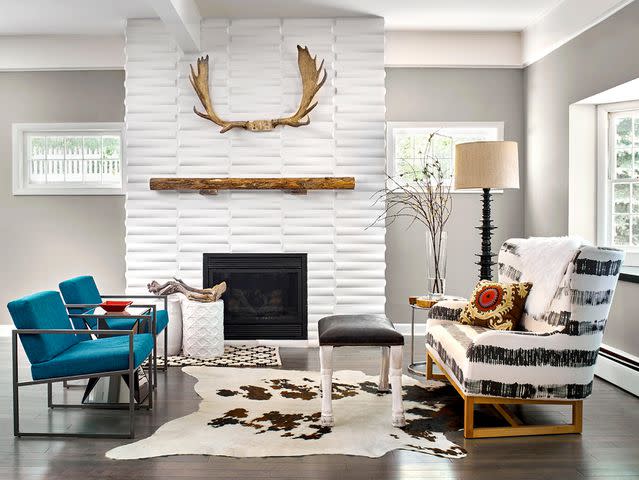What Are Engineered Hardwood Floors? Plus the Pros, Cons, and Cost
Is engineered wood flooring right for your home? Get to know the pros and cons of this modern alternative to traditional hardwood.

Kim Cornelison
Known for durability and style, hardwood floors have been a go-to flooring option for centuries. However, hardwood trees are slow growers and the demand for beautiful, durable floors isn’t slowing down. The solution? Engineered wood.
Unlike traditional hardwood flooring, which consists of solid wood planks, engineered wood planks consist of a thin top layer of hardwood glued to an engineered base. The word “engineered” is a technical term for wood boards that have been formed using wood pieces and adhesives. While there are many types of engineered woods, the most common is plywood. We’ve broken down the pros and cons of engineered wood flooring so you can see how it stacks up against traditional hardwood.
What Is Engineered Wood Flooring?
Engineered wood flooring consists of a hardwood top layer glued to a base layer that often consists of plywood or OSB (oriented strand board). Because of this design, engineered wood looks virtually the same as traditional hardwood once installed.

Pros of Engineered Wood Flooring
Cost: When compared to traditional hardwood, engineered wood nearly always has a lower price point. However, this is only true when compared laterally. For instance, high-performance exotic engineered flooring might be more expensive than standard solid red-oak flooring. Additionally, many of the savings associated with engineered flooring are on the installation, as it’s quicker to install and often comes prefinished.
Warp-Resistance: Because of its construction, engineered flooring is resistant to warping and splitting due to moisture exposure and temperature variance.
Ease of Installation: On average, engineered flooring is much easier and quicker to install than traditional hardwood, making it a great DIY flooring solution. Many options even join with a locking click, requiring no special fasteners, which makes installation even faster.
Installation Flexibility: Engineered wood flooring performs in environments that solid wood flooring simply can’t. This includes installation on top of radiant floor heating, concrete slabs, in basements, and in humid environments. Many waterproof varieties are also available, making wood floors possible in places they’ve never been before.
Cons of Engineered Wood Flooring
Refinishing Limitations: Unlike traditional hardwood, which can be refinished time and time again, engineered wood flooring is limited to minimal resurfacing. Even the best engineered options with the thickest wear layers can only be refinished around three times, while inexpensive options are limited to one. Floors with a wear layer of less than 2mm should only be lightly buffed.
Prone to Fading: Engineered wood is prone to fading in the sun. While this is true of many hardwood varieties as well, it’s of greater concern for engineered floors due to refinishing limitations.
VOCs: Because engineered flooring is constructed with adhesives and chemicals, there is a risk of VOC off-gassing. This is when VOCs (volatile organic compounds) are released from the floor after installation. While this isn’t an issue with all engineered floors, cheaper varieties are more prone to off-gassing. Pay close attention to your manufacturer’s instructions and look for floors with low- or no-VOC labels.
Varieties of Engineered Wood Flooring
Like most building materials, not all engineered wood flooring is the same and it’s important to familiarize yourself with the differences to make an educated purchase. Beyond aesthetic differences of top layer materials and finishes, the anatomy of one engineered wood plank can vastly differ from another. Things like core thickness (base layer), wear layer thickness (top), number of finish coats, and materials will all play a part in the quality and longevity of an engineered wood floor.

Features of Engineered Wood Flooring
Below are standard features to be aware of when shopping for engineered floors as well as how the features effect the overall quality of the wood.
Wear Layer Thickness: The thicker the wear layer is, the more times the floor can be refinished.
Wear Layer Hardness: A harder wear layer results in a more durable floor.
Core Thickness: A thicker core will result in a more durable floor. While core construction varies from brand to brand, a good rule of thumb is to look for plywood construction with multiple layers. Generally speaking, the more layers the better.
Finish Coats: The number of finish coats is directly linked to the durability of the flooring, as more finish coats add a thicker layer of protection.
Tiers of Engineered Flooring
Below are the three standard tiers of engineered flooring boards followed by their price points and features you should expect.
Budget ($2 to $5 per sq. ft.): Engineered flooring in this class features a thin 1-2 mm wear layer, up to 5 finish coats, a 10- to 15-year warranty, and is limited to only certain finishes and wear layer varieties.
Average ($6 to $10 per sq. ft.): With slightly more options for finishes and wood species, average engineered flooring features a 2-3 mm wear layer, up to 7 finish coats, and a 15- to 25-year warranty.
Premium: ($11 to $18 per sq. ft.): With the largest selection of hardwoods, exotic options, and finishes, premium engineered flooring features a thicker 7-9 ply base, a minimum of 3 mm wear layer, 7-9 finish coats, and a 25-year to lifetime warranty.
Maintaining Engineered Wood Floors
Just like traditional hardwood, engineered floors must be regularly maintained and cleaned with special care. Water should be used sparingly, and harsh cleaners should be avoided, as they can damage and dull the finish. Spills should be immediately wiped up to avoid water damage. Furthermore, heat and steam cleaning should be avoided, as this can damage the flooring and weaken the bond of the adhesive. For best results, a gentle floor cleaner is recommended unless otherwise specified by the manufacturer.

